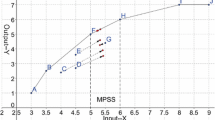Abstract
This paper is concerned with the resource allocation problem based on data envelopment analysis (DEA) which is generally found in practice such as in public services and in production process. In management context, the resource allocation has to achieve the effective-efficient-equality aim and tries to balance the different desires of two management layers: central manager and each sector. In mathematical programming context, to solve the resource allocation asks for introducing many optimization techniques such as multiple-objective programming and goal programming. We construct an algorithm framework by using comprehensive DEA tools including CCR, BCC models, inverse DEA model, the most compromising common weights analysis model, and extra resource allocation algorithm. Returns to scale characteristic is put major place for analyzing DMUs’ scale economies and used to select DMU candidates before resource allocation. By combining extra resource allocation algorithm with scale economies target, we propose a resource allocation solution, which can achieve the effective-efficient-equality target and also provide information for future resource allocation. Many numerical examples are discussed in this paper, which also verify our work.
Similar content being viewed by others
References
A. Charnes, W. W. Cooper, and E. Rhodes, Measuring the efficiency of decision making units, European Journal of Operational Research, 1978, 2(6): 429–444.
A. Charnes, W. W. Cooper, B. Golany, L. Seiford, and J. Stutz, Foundations of data envelopment analysis for Pareto-Koopmans efficient empirical production functions, Journal of Econometrics, 1985, 30(1): 91–107.
W. D. Cook and M. Kress, A data envelopment model fore aggregating preference ranking, Management Science, 1990, 36(11): 1302–1310.
A. Andersen and N. C. Petersen, A procedure for ranking efficient units in data envelopment analysis, Management Science, 1993, 39(10): 1261–1264.
N. Adler, L. Friedman, and Z. Sinuany-Stern, Review of ranking methods in the data envelopment analysis context, European Journal of Operational Research, 2002, 140(2): 249–263.
R. D. Banker, A. Charnes, and W. W. Cooper, Some models for estimating technical and scale inefficiencies in data envelopment analysis, Management Science, 1984, 30(9): 1079–1092.
A. D. Athanassopoulos, Decision support for target-based resource allocation of public services in multiunit and multilevel system, Management Science, 1998, 44(2): 173–187.
P. Korhonen and M. Syrjanen, Resource allocation based on efficiency analysis, Management Science, 2004, 50(8): 1134–1144.
X. S. Zhang and J. C. Cui, A project evaluation system in the state economic information system of China–An operations research practice in public sectors, International Transactions on Operations Research, 1999, 6(5): 441–452.
Q. L. Wei, J. Z. Zhang, and X. S. Zhang, An inverse DEA model for inputs/outputs estimate, European Journal of Operational Research, 2000, 121(1): 151–163.
Golany, An interactive MOLP procedure for the extension of DEA to effectiveness analysis, Journal of Operation Research Society, 1988, 39(8): 725–734.
Golany and E. Tamir, Evaluating efficiency-effectiveness-equality trade-offs, Management Science, 1995, 41(7): 1172–1184.
W. W. Cooper, L. M. Seiford, and Kaoru Tone, Data Envelopment Analysis: A Comprehensive Text with Models, Applications, References, and DEA-Solver Software, Kluwer Academic Publishers, Norwell, MA, 2000.
R. D. Banker and R. M. Thrall, Estimation of returns to scale using data envelopment analysis, European Journal of Operational Research, 1992, 62(1): 74–84.
Z. H. Sheng, Q. Zhu, and G. M. Wu, DEA–Theory, Methodology and Application (in Chinese), Science Press, Beijing, 1996.
H. Yan, Q. L. Wei, and G. Hao, DEA models for resource reallocation and production input/output estimation, European Journal of Operational Research, 2002, 136(1): 19–31.
X. S. Zhang, J. C. Cui, and X. Y. Li, Remodelling of the inverse DEA model: A prediction tool for not-for-profit organizations, Lecture Notes in Operations Research, World Publishing Corporation, Beijing, 2007, 7: 367–375.
Franklin Liu and H. H. Peng, Ranking DEA efficient units with the most compromising common weights, the 6th International Symposium on Operations Research and Its Applications (ISORA’06), 2006, 6: 219–234.
X. Y. Li and J. C. Cui, Extra resource allocation problem with the most compromise common weights based on DEA, Lecture Notes in Operations Research, ORSC&APORC, 2007, 7: 397–404.
R. G. D. Allen, Mathematical Analysis for Economists, The MacMillan Co., New York, 1939.
C. Kao and H. T. Hung, Data envelopment analysis with common weights: The compromise solution approach, Journal of the Operational Research Society, 2005, 56(11): 1196–1203.
X. Y. Li and J. C. Cui, Arithmetic of extra resource allocation based on DEA method, Journal of Systems Engineering (in Chinese), 2007, 22(1): 57–61.
D. Wade Cook and Moshe Kress, Characterizing an equitable allocation of shared costs: A DEA approach, European Journal of Operational Research, 1999, 119(3): 652–661.
Ryuichi Ito, Takashi Namatame, and Toshikazu Yamaguchi, Resource allocation problem based on the DEA model, Journal of the Operations Research Society of Japan, 1999, 42(2): 149–166.
Author information
Authors and Affiliations
Corresponding author
Additional information
This research is supported by 973 Program under Grant No. 2006CB701306.
Rights and permissions
About this article
Cite this article
LI, X., CUI, J. A Comprehensive Dea Approach for the Resource Allocation Problem based on Scale Economies Classification. J Syst Sci Complex 21, 540–557 (2008). https://doi.org/10.1007/s11424-008-9134-6
Received:
Published:
Issue Date:
DOI: https://doi.org/10.1007/s11424-008-9134-6



